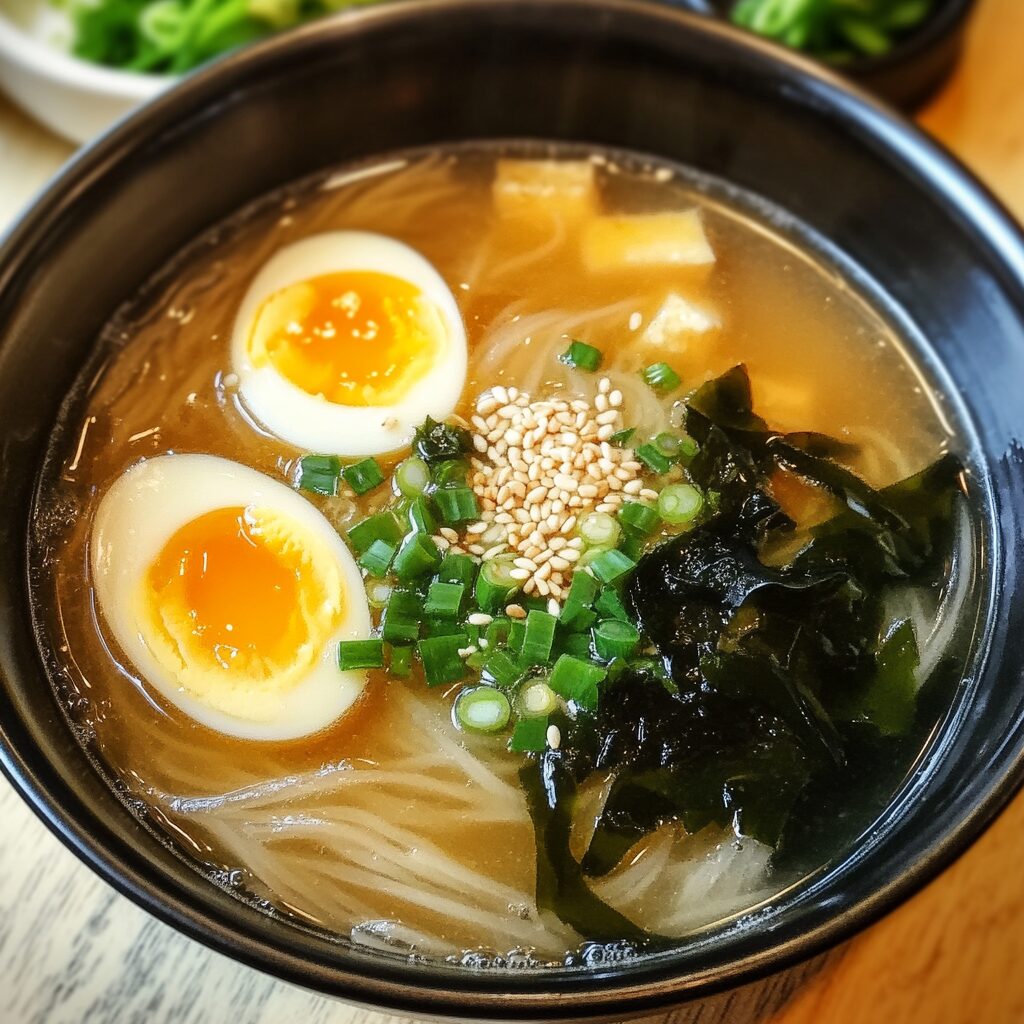Japanese Glass Noodle Soup, or Harusame Soup, is a comforting and light dish that features delicate glass noodles in a flavorful broth, often made with a combination of dashi, soy sauce, and mirin. This soup is typically served with vegetables, mushrooms, and sometimes thinly sliced meat or tofu, creating a warm, savory meal that’s both satisfying and light.
I first made Harusame Soup when I was craving something warm and nourishing but not too heavy. The glass noodles were light yet filling, and the broth had a savory depth that was both comforting and refreshing. I loved how quickly the soup came together, and how customizable it was—adding in some fresh greens or tofu made it even more satisfying.
Full Recipe
Ingredients:
-
2 large eggs
-
2 green onions/scallions
-
3.5 oz medium-firm tofu (¼ block)
-
2 Tbsp dried wakame seaweed
-
2 tsp toasted sesame oil
-
2 cups chicken stock/broth (use vegetable stock for vegan/vegetarian)
-
2 cups water
-
1½ Tbsp soy sauce (use gluten-free soy sauce for GF)
-
1 tsp Diamond Crystal kosher salt (adjust based on your chicken stock as some brands can be salty; add ½ tsp first, then add more after tasting)
-
¼ tsp white pepper powder
-
1 oz dried glass/cellophane noodles (harusame)
-
2 tsp toasted white sesame seeds
Directions:
-
Gather all the ingredients.
-
Beat 2 large eggs (50 g each w/o shell) in a measuring cup or in a bowl with a spout.
-
Cut the white part of 2 green onions/scallions into thin round pieces. Then, thinly slice the green part diagonally.
-
Rehydrate the dried wakame seaweed in water and set aside.
-
In a medium saucepan, heat 2 tsp toasted sesame oil over medium heat.
-
Add the chicken stock/broth and water to the saucepan and bring to a simmer.
-
Add 1½ Tbsp soy sauce, 1 tsp kosher salt, and ¼ tsp white pepper powder to the broth. Stir to combine.
-
Slowly pour a steady trickle of the beaten eggs into the soup in a circular motion, starting from the center and spiraling outward. Let the eggs sit without stirring for 20–25 seconds until they’re fluffy and just cooked.
-
Add the rehydrated wakame seaweed, green parts of the green onions, and 2 tsp toasted white sesame seeds. Remove the saucepan from the heat to prevent overcooking.
-
Transfer the glass noodles to individual bowls with a pair of tongs. Then pour the soup and other ingredients over the noodles. Serve hot.
Prep Time: 10 minutes
Cooking Time: 10 minutes
Total Time: 20 minutes
Kcal: Approximately 115 kcal per serving
Servings: 4 servings
Introduction to Harusame Soup: A Staple of Japanese Home Cooking
Harusame soup is a traditional Japanese dish that exemplifies the art of simplicity and balance in the cuisine of Japan. “Harusame” literally translates to “spring rain,” which poetically describes the delicate, translucent nature of the glass noodles used in the soup. These noodles, often made from mung bean starch or potato starch, become silky and slightly chewy when cooked, creating a pleasing texture that contrasts beautifully with the rich, savory broth. The dish is a gentle, soothing option for those seeking something nourishing yet light on the stomach.
This soup is incredibly versatile, often adapted by home cooks to reflect the season, available ingredients, or dietary preferences. Whether served as a light starter, a soothing meal during illness, or a main dish in a vegetarian spread, Harusame soup holds its own with quiet strength and elegance. Its mild yet umami-rich broth, the slippery texture of the noodles, and the healthy additions like tofu and wakame make it a favorite across all age groups in Japan.
The Role of Glass Noodles in Japanese Cuisine
Glass noodles—or “harusame”—are integral not just to this soup, but also to various other Japanese dishes such as salads (harusame salad), stir-fries, and hot pots. Their neutral flavor allows them to absorb surrounding tastes, making them a perfect carrier of umami-laden broths. Unlike wheat noodles, glass noodles are naturally gluten-free, which makes them ideal for people with dietary restrictions.
Their texture is another defining feature: soft, springy, and smooth, they create a satisfying slurp with each bite. When used in soups, they provide body without weighing down the dish, making the entire experience both hearty and light.
Traditional Ingredients and Their Health Benefits
While every household might prepare Harusame soup slightly differently, the standard components typically include tofu, wakame (a type of seaweed), scallions, sesame oil, and a seasoned broth made from chicken or vegetable stock, soy sauce, and white pepper. Each of these ingredients brings both flavor and nutritional value.
Tofu, for instance, is a plant-based protein powerhouse, low in calories but rich in essential amino acids and iron. Wakame is known for its iodine content, which supports thyroid function, as well as its anti-inflammatory and antioxidant properties. Sesame oil, though used sparingly, provides healthy fats and a warm, nutty aroma that ties the dish together. Soy sauce and white pepper add umami depth and a mild heat that enlivens the delicate broth.
All of these components align with the Japanese culinary principle of “ichiju-sansai”—one soup and three sides—a traditional meal format designed for nutritional balance and variety.
A Soup for All Seasons and Situations
Harusame soup is remarkably adaptable and can be enjoyed throughout the year. In the colder months, it serves as a comforting bowl of warmth, especially with added ginger or chili for heat. During the warmer months, it can be served slightly cooler or with lighter garnishes like thinly sliced cucumber or chilled tofu.
It is also a go-to dish for those recovering from illness, much like chicken soup in Western cultures. Its gentle, easy-to-digest ingredients make it suitable for children, the elderly, or anyone with a sensitive stomach. Moreover, its minimal oil and natural components fit perfectly into a low-fat, low-calorie diet.
For vegans and vegetarians, the recipe is easily modified—use vegetable broth instead of chicken, skip the egg, and increase the amount of tofu or add mushrooms for extra umami. This flexibility ensures that Harusame soup can cater to a wide range of dietary needs without sacrificing taste.
Cultural Significance of Harusame Soup in Japan
In Japan, food is often more than sustenance; it is an expression of respect for nature, seasons, and the eater’s well-being. Harusame soup reflects all of these values. Its ingredients are simple and seasonal. Its preparation is meditative yet efficient, and its presentation is thoughtful—served in clean bowls, sometimes with a sprinkle of sesame seeds or a touch of color from scallions.
It’s not typically considered a luxury dish, but rather a part of everyday meals that families gather around. This elevates its importance: it is the kind of food that forms the foundation of comfort, the type that evokes memories of home, mother’s cooking, or quiet evenings at the dinner table.
In bento boxes, school lunches, or home-cooked dinners, Harusame soup often appears as a symbol of warmth and care. It’s the kind of dish people return to, time and again, for its dependability and its subtle charm.
How to Customize Harusame Soup at Home
One of the best parts about making Harusame soup is how easy it is to customize. You can create variations based on dietary preferences, available ingredients, or regional influences. Some common customizations include:
-
Adding proteins: Thinly sliced chicken, shrimp, or even a poached egg can turn this light soup into a more filling meal.
-
Vegetable upgrades: Shiitake mushrooms, carrots, napa cabbage, or spinach can enrich the flavor and texture profile.
-
Spice variations: A dash of chili oil, fresh grated ginger, or a spoonful of miso paste can change the entire character of the soup.
-
Garnish options: Toasted sesame seeds, nori strips, or even a drizzle of lemon juice can elevate the presentation and taste.
These add-ons do not just change the flavor; they offer opportunities to experiment and make the dish your own. Whether you’re craving something clean and traditional or bold and fusion-inspired, Harusame soup offers the perfect base.
Why This Dish Appeals to a Modern Audience
In a time when health-conscious eating, gluten-free diets, and quick home meals are in high demand, Harusame soup ticks all the boxes. It’s low in calories, gluten-free, and packed with nutrients. Better yet, it’s easy to make in under 30 minutes, making it an ideal choice for busy professionals, students, and families alike.
Modern interpretations have seen the soup reimagined with international flair—some people add Thai lemongrass, Korean kimchi, or even Western elements like kale and quinoa. This global adaptation shows how beloved and versatile the dish has become.
Moreover, the soup’s visually appealing presentation—translucent noodles, vibrant greens, and softly set egg ribbons—makes it perfect for social media posts, cooking blogs, and even upscale restaurant menus. Despite its humble roots, it has the potential to be a culinary star.
Conclusion
Harusame soup is more than just a dish—it’s a reflection of Japanese culinary philosophy, which values balance, simplicity, and natural goodness. It’s the kind of food that soothes you when you’re sick, warms you on cold days, and satisfies you without ever feeling heavy. Its light yet flavorful broth, paired with soft tofu, springy noodles, and nutrient-rich seaweed, makes every spoonful a journey into both comfort and tradition.
As more people across the world embrace wellness-focused diets and crave easy, satisfying meals at home, Harusame soup continues to grow in popularity beyond Japan. It encourages creativity in the kitchen, supports dietary needs, and invites us to slow down, savor, and nourish our bodies with intention.
Whether you’re new to Japanese cuisine or a seasoned home cook, adding Harusame soup to your regular rotation is a decision your tastebuds—and your body—will thank you for.






